

File photo shows researchers of China's Large High Altitude Air Shower Observatory (LHAASO) He Huihai (R), Xin Guangguang (C) and Yuan Xiangfei talking about scientific data, on April 28, 2019. Chinese scientists have detected a dozen ultra-high-energy (UHE) cosmic accelerators within the Milky Way, a find that could overturn humanity's understanding of the galaxy and help reveal the origin of cosmic rays, which have puzzled scientists for a century. The findings were based on the observations of China's Large High Altitude Air Shower Observatory (LHAASO), one of the country's key national science and technology infrastructure facilities, which is under construction in Daocheng, in southwest China's Sichuan Province. The new discoveries were published in Nature on Monday. Scientists have also detected photons with energies exceeding 1 peta-electron volt (quadrillion electron-volts or PeV), 100 times more energy than the record high achieved by any manmade accelerator on Earth. One photon with an energy of 1.4 PeV was detected, the highest value ever observed by humans. (Xinhua/Jin Liwang)
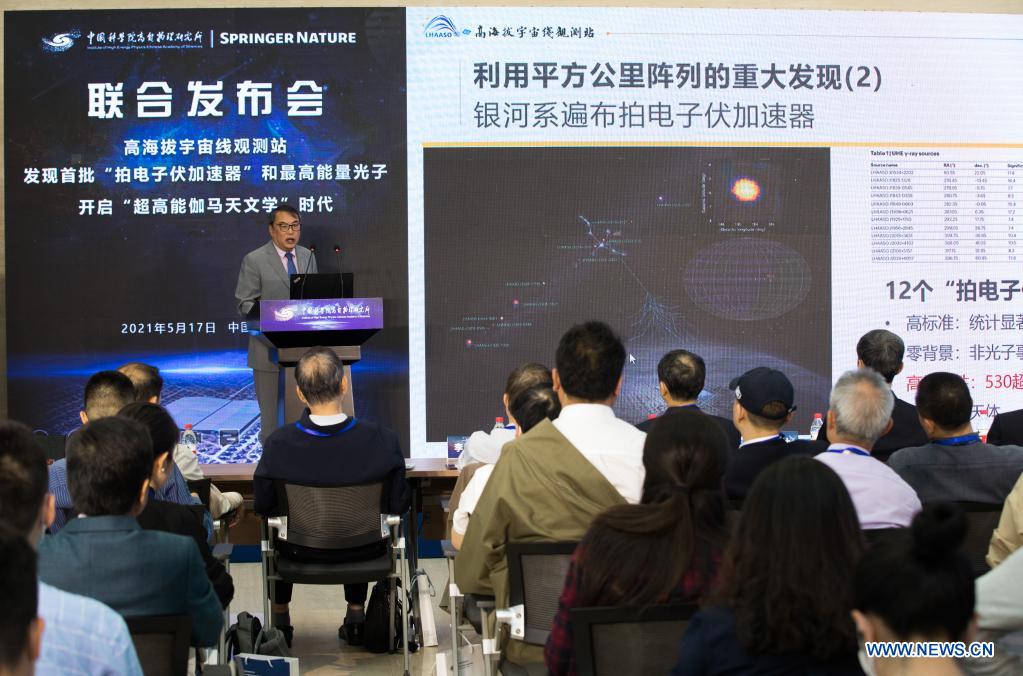
Cao Zhen, a researcher at the Institute of High Energy Physics (IHEP) under the Chinese Academy of Sciences (CAS), speaks at a press conference in Beijing, capital of China on May 17, 2021. Chinese scientists have detected a dozen ultra-high-energy (UHE) cosmic accelerators within the Milky Way, a find that could overturn humanity's understanding of the galaxy and help reveal the origin of cosmic rays, which have puzzled scientists for a century. The findings were based on the observations of China's Large High Altitude Air Shower Observatory (LHAASO), one of the country's key national science and technology infrastructure facilities, which is under construction in Daocheng, in southwest China's Sichuan Province. The new discoveries were published in Nature on Monday. Scientists have also detected photons with energies exceeding 1 peta-electron volt (quadrillion electron-volts or PeV), 100 times more energy than the record high achieved by any manmade accelerator on Earth. One photon with an energy of 1.4 PeV was detected, the highest value ever observed by humans. (Xinhua/Jin Liwang)
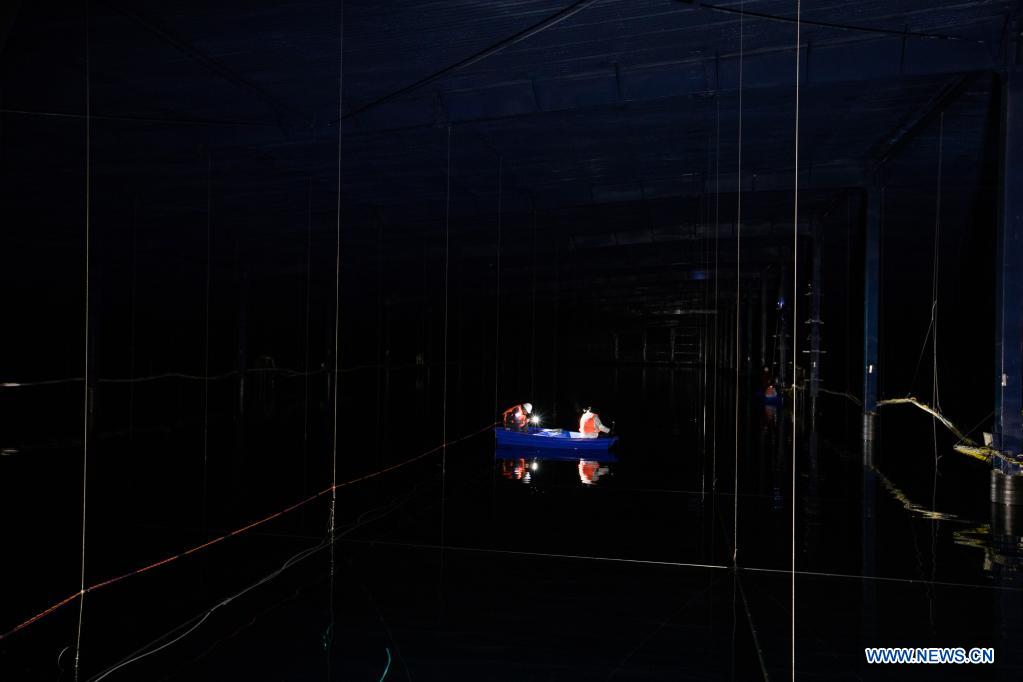
Cao Zhen (L), a researcher at the Institute of High Energy Physics (IHEP) under the Chinese Academy of Sciences (CAS), conducts maintenance with staff members at China's Large High Altitude Air Shower Observatory (LHAASO) in Daocheng, southwest China's Sichuan Province, April 28, 2019. Chinese scientists have detected a dozen ultra-high-energy (UHE) cosmic accelerators within the Milky Way, a find that could overturn humanity's understanding of the galaxy and help reveal the origin of cosmic rays, which have puzzled scientists for a century. The findings were based on the observations of China's Large High Altitude Air Shower Observatory (LHAASO), one of the country's key national science and technology infrastructure facilities, which is under construction in Daocheng, in southwest China's Sichuan Province. The new discoveries were published in Nature on Monday. Scientists have also detected photons with energies exceeding 1 peta-electron volt (quadrillion electron-volts or PeV), 100 times more energy than the record high achieved by any manmade accelerator on Earth. One photon with an energy of 1.4 PeV was detected, the highest value ever observed by humans. (Xinhua/Jin Liwang)
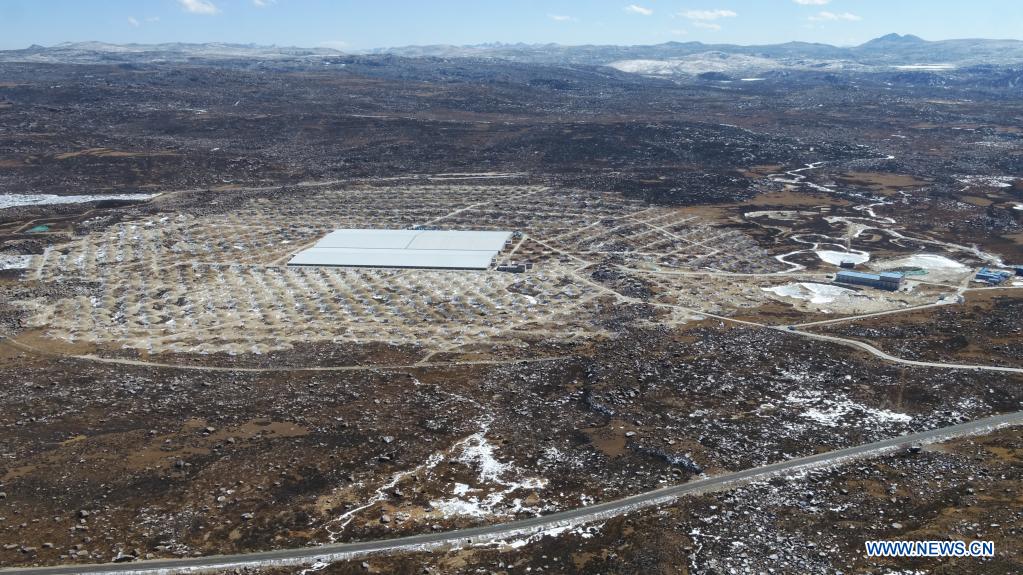
Aerial photo taken on Feb. 2, 2021 shows China's Large High Altitude Air Shower Observatory (LHAASO) in Daocheng, southwest China's Sichuan Province. Chinese scientists have detected a dozen ultra-high-energy (UHE) cosmic accelerators within the Milky Way, a find that could overturn humanity's understanding of the galaxy and help reveal the origin of cosmic rays, which have puzzled scientists for a century. The findings were based on the observations of China's Large High Altitude Air Shower Observatory (LHAASO), one of the country's key national science and technology infrastructure facilities, which is under construction in Daocheng, in southwest China's Sichuan Province. The new discoveries were published in Nature on Monday. Scientists have also detected photons with energies exceeding 1 peta-electron volt (quadrillion electron-volts or PeV), 100 times more energy than the record high achieved by any manmade accelerator on Earth. One photon with an energy of 1.4 PeV was detected, the highest value ever observed by humans. (IHEP/Handout via Xinhua)
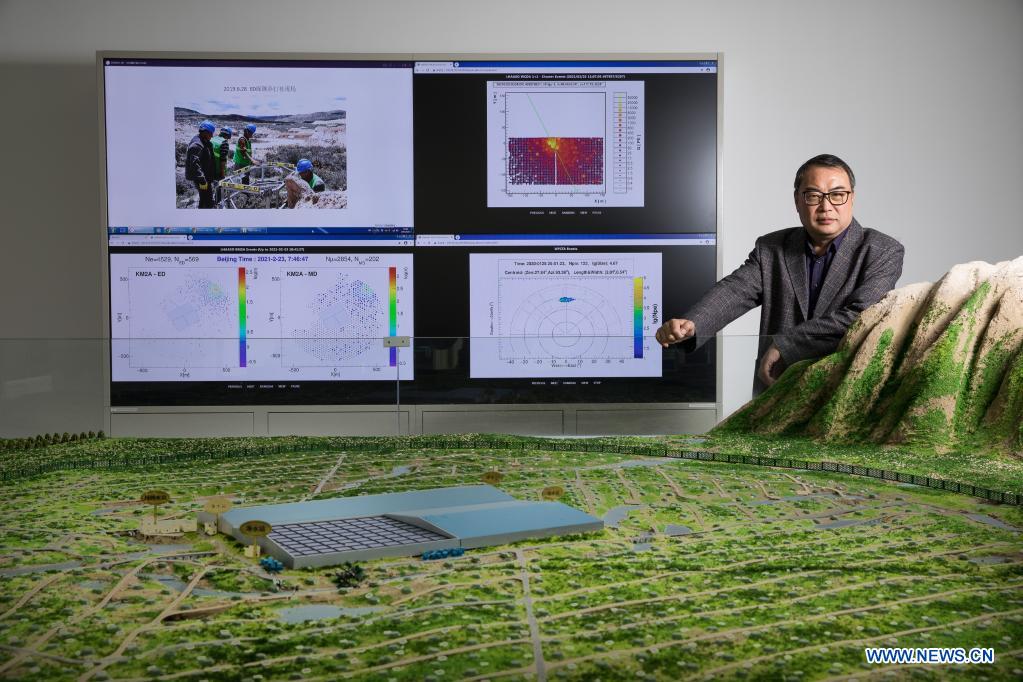
Cao Zhen, a researcher at the Institute of High Energy Physics (IHEP) under the Chinese Academy of Sciences (CAS), poses for a photo in front of a sandtable of China's Large High Altitude Air Shower Observatory (LHAASO), in Beijing, capital of China on Feb. 23, 2021. Chinese scientists have detected a dozen ultra-high-energy (UHE) cosmic accelerators within the Milky Way, a find that could overturn humanity's understanding of the galaxy and help reveal the origin of cosmic rays, which have puzzled scientists for a century. The findings were based on the observations of China's Large High Altitude Air Shower Observatory (LHAASO), one of the country's key national science and technology infrastructure facilities, which is under construction in Daocheng, in southwest China's Sichuan Province. The new discoveries were published in Nature on Monday. Scientists have also detected photons with energies exceeding 1 peta-electron volt (quadrillion electron-volts or PeV), 100 times more energy than the record high achieved by any manmade accelerator on Earth. One photon with an energy of 1.4 PeV was detected, the highest value ever observed by humans. (Xinhua/Jin Liwang)
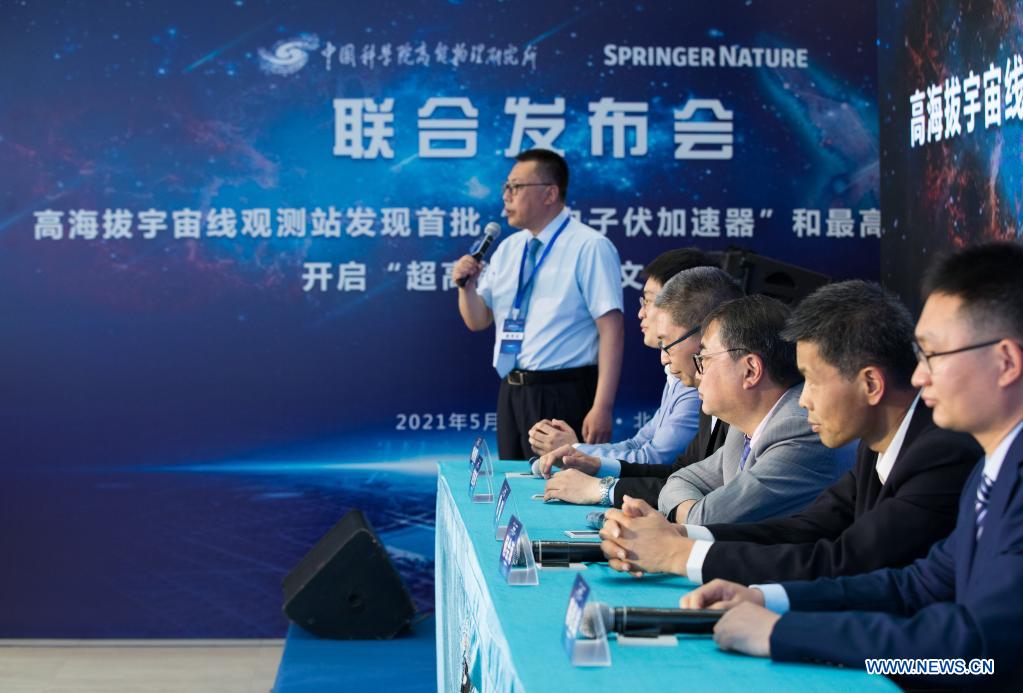
A researcher answers questions at a press conference held at the Institute of High Energy Physics (IHEP) under the Chinese Academy of Sciences (CAS) in Beijing, capital of China on May 17, 2021. Chinese scientists have detected a dozen ultra-high-energy (UHE) cosmic accelerators within the Milky Way, a find that could overturn humanity's understanding of the galaxy and help reveal the origin of cosmic rays, which have puzzled scientists for a century. The findings were based on the observations of China's Large High Altitude Air Shower Observatory (LHAASO), one of the country's key national science and technology infrastructure facilities, which is under construction in Daocheng, in southwest China's Sichuan Province. The new discoveries were published in Nature on Monday. Scientists have also detected photons with energies exceeding 1 peta-electron volt (quadrillion electron-volts or PeV), 100 times more energy than the record high achieved by any manmade accelerator on Earth. One photon with an energy of 1.4 PeV was detected, the highest value ever observed by humans. (Xinhua/Jin Liwang)
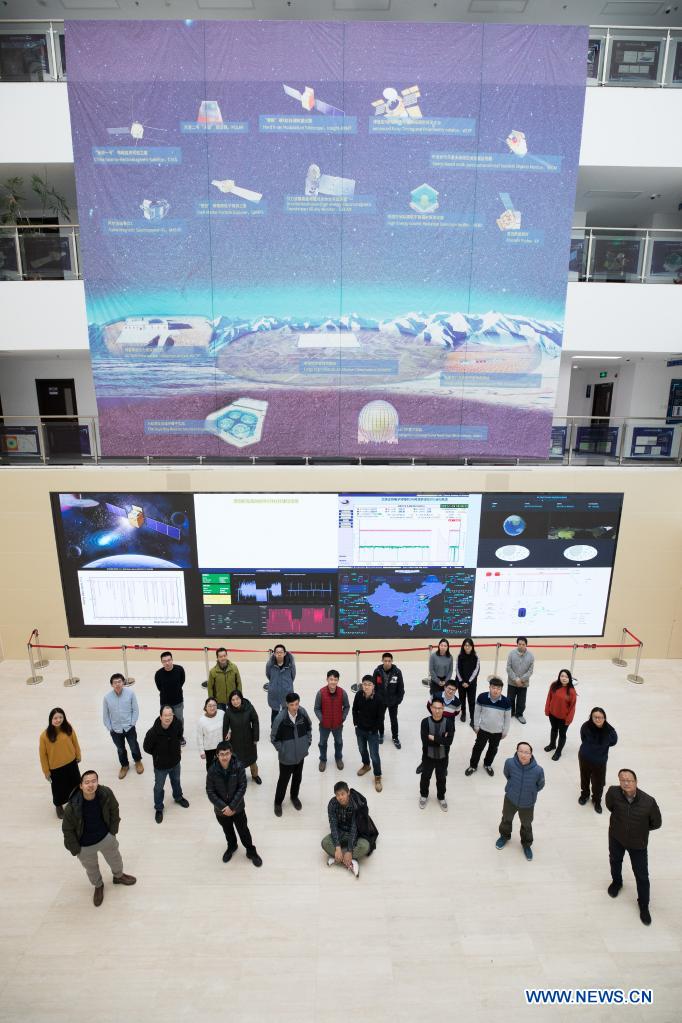
Some researchers of China's Large High Altitude Air Shower Observatory (LHAASO) pose for a group photo at the Institute of High Energy Physics (IHEP) under the Chinese Academy of Sciences (CAS) in Beijing, capital of China, on Jan. 19, 2021. Chinese scientists have detected a dozen ultra-high-energy (UHE) cosmic accelerators within the Milky Way, a find that could overturn humanity's understanding of the galaxy and help reveal the origin of cosmic rays, which have puzzled scientists for a century. The findings were based on the observations of China's Large High Altitude Air Shower Observatory (LHAASO), one of the country's key national science and technology infrastructure facilities, which is under construction in Daocheng, in southwest China's Sichuan Province. The new discoveries were published in Nature on Monday. Scientists have also detected photons with energies exceeding 1 peta-electron volt (quadrillion electron-volts or PeV), 100 times more energy than the record high achieved by any manmade accelerator on Earth. One photon with an energy of 1.4 PeV was detected, the highest value ever observed by humans. (Xinhua/Jin Liwang)

86-10-68597521 (day)
86-10-68597289 (night)

52 Sanlihe Rd., Xicheng District,
Beijing, China (100864)

